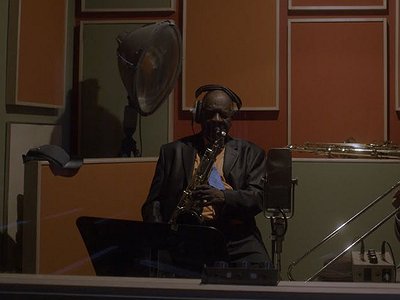Name: Wendell Harrison
Nationality: American
Occupation: Clarinetist, tenor saxophonist, improviser
Current release: Wendell Harrison teams up with Phil Ranelin, Adrian Younge and Ali Shaheed Muhammad for JID016, out January 27th 2023 via Jazz is Dead.
If you enjoyed this interview with Wendell Harrison and would like to know more about his music, visit his official website. For an interview with one of his collaborators on Jazz Is Dead 011 , read our Garrett Saracho interview.
As a child, I started playing the piano the age of five years old, to develop discipline and concentration. This effort and strategy was my mother’s idea, however when I was eight, my grandfather brought a clarinet for me play in the school band, where I learned to read music and play in tune.
I became very interested in improvisation when I was in the 10th grade in high school playing clarinet. I was mesmerized by Charlie Parker and Dizzy Gillespie and the be-bop phenomon in the 50s. I grew up in the 40s and 50s and blues, soul r&b, latin and jazz were all part of Black culture. As I learned to perform, I had to play for dances, weddings and church events. The be-bop ideas that I had developed were integrated with various formats and styles.
There was a supporting community of older musicians that hired me to perform in their ensembles, which was a vital part of my development as a performing artist and musician.
~
Young jazz students were rehearsing in the band room, who became jazz greats in the jazz world. These musicians were around two years older than me and graduated before I did. Some of the students were Roy Brook- Drums, Charles McPherson- Alto Saxophone, James Jamison- Bass, Lonnie Hillyer-trumpet. These musicians started their career by going to New York after graduating from high school and performing with iconic jazz bassist Charlie Mingus, except James Jamison who became Motown Record’s main studio musician, making several hit records.
My concentration increased and after hearing these young students practicing be-bop jazz. I begged my mother to purchase me an alto saxophone. Also, I asked Lonnie to teach me ideas, jazz exercises as well as standard jazz songs. I started lessons with the great Barry Harris, which gave me additional foundation for improvisation.
The alto saxophone was appealing because was listening to Charlie Parker and his instrument was the alto saxophone. However, before I graduated from Northwestern high school, I switched to tenor saxophone due to the Sonny Rollins and John Coltrane influence.
~
At 19 years, in 1960, I moved to New York and began performing with a variety of artist, from jazz, blues, r&b, avant- vanguard. In becoming a stylist and an eclectic music in the jazz diaspora, I was influenced by many artists. I listened to an abundance of LP records when I was a teenager. Also, after I'd moved to New York, I played and studied with the iconic Sonny Rollins. Furthermore, jazz legend John Coltrane was very popular in the 60s, and he influenced me and my performances as well.
While working and recording with Hank Crawford and Grant Green, I acquired my own jazz voice and working with Sun-Ra gave my sound an edge and bite. Playing with Sun Ra was a great experience and opportunity in shaping my imagination and improvisation. Vocalist Marvin Gay, Big Maybelle, Chuck Jackson, Dione Warwick, Lou Rawls, Esther Phillips, Proof (hip hop Artist),Carl Craig-techno artist guru and many others introduced me to the main stream blues and pop market.
My development led me to various improvisation approaches. As I performed with many great artists and performers, I adapted several styles and incorporated them in my musical voice or expression.
~
I expanded my sound and presentation by playing the flute and in the 70s started recording with the flute, soprano and tenor saxophone. In the 80s I expanded again by revisiting the clarinet. I continued to perform throughout the 90s, playing flute, clarinet and tenor saxophone. In 2000, I added the bass clarinet.
So, the last twenty years I have been performing and recording on the tenor saxophone, bass clarinet, and Bb or soprano clarinet. Recording for Adrian Young and Ali Shaheed Muhammad as well my partner Phil Ranelin was an epic experience. I think this collaboration produced a great album for the “Jazz Is Dead” label. We are getting a positive response from the young jazz enthusiasts.
~
Some of the motivation in playing different woodwinds is the variety of sounds it brings to your performance. I like having more colors in the crayon box. During the recording session for JID016 I got a chance to use some of the ideas on the bass clarinet that were inspired by Adrian and Ali. Phil is always generating enthusiasm and fire.
In collaborating with creative musicians, you will always in the end manifest a prolific product. Experience means a lot and we had lot between the four of us. It is a process, we recorded for two days, which included discussing sounds and strategy. In the end the session was a felicitous and rewarding event. Sounds, colors as well as funky rhythms were inspiring on this session. Rhythm alone can generate a plethora of ideas to serve as a foundation to create harmony, ecstasy and excitement, which was exemplified on this recording.
I have recorded over thirty releases on Tribe, Rebirth and Wenha label, also Atlantic and Columbia records and it’s a labor of love.




